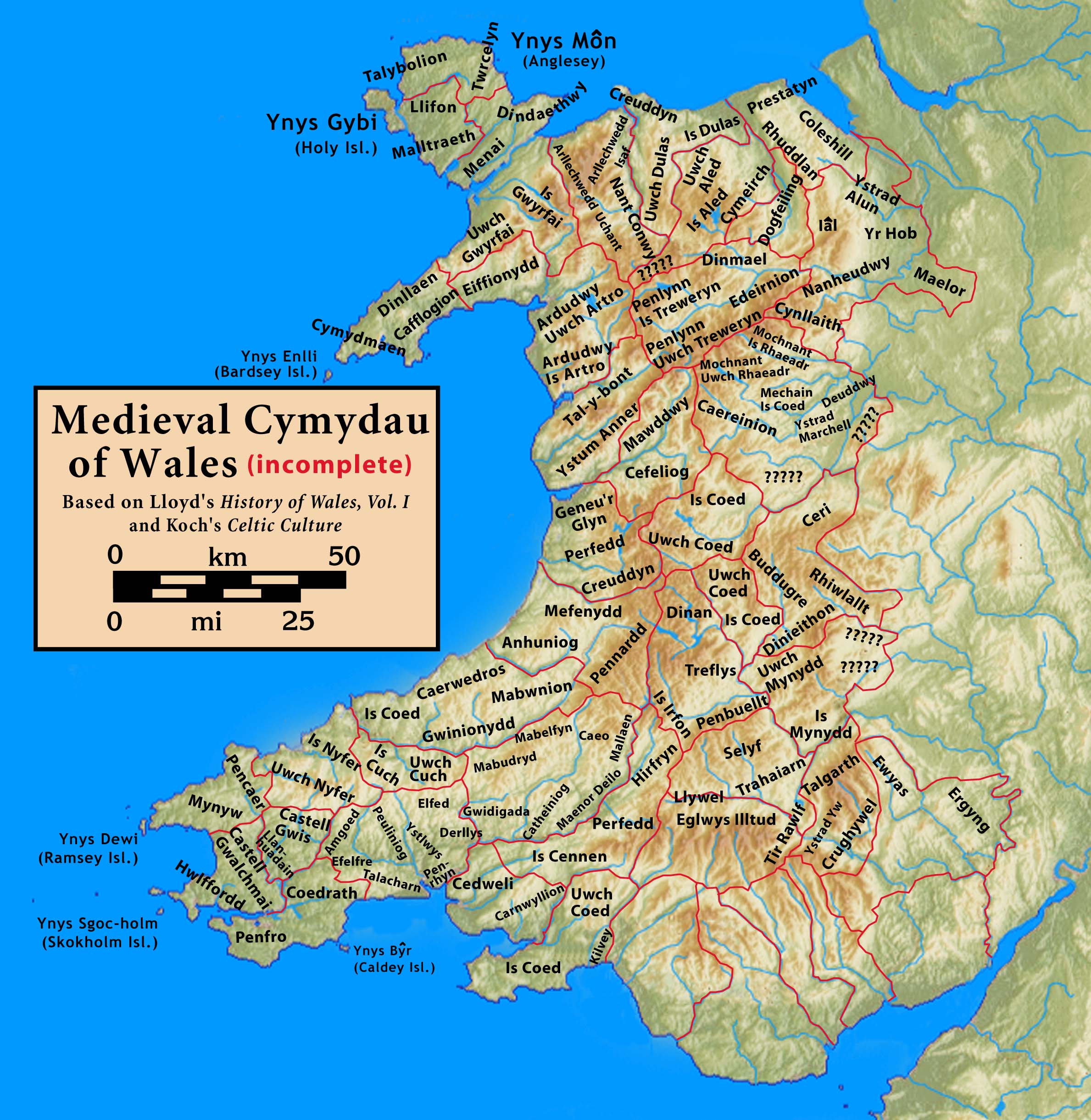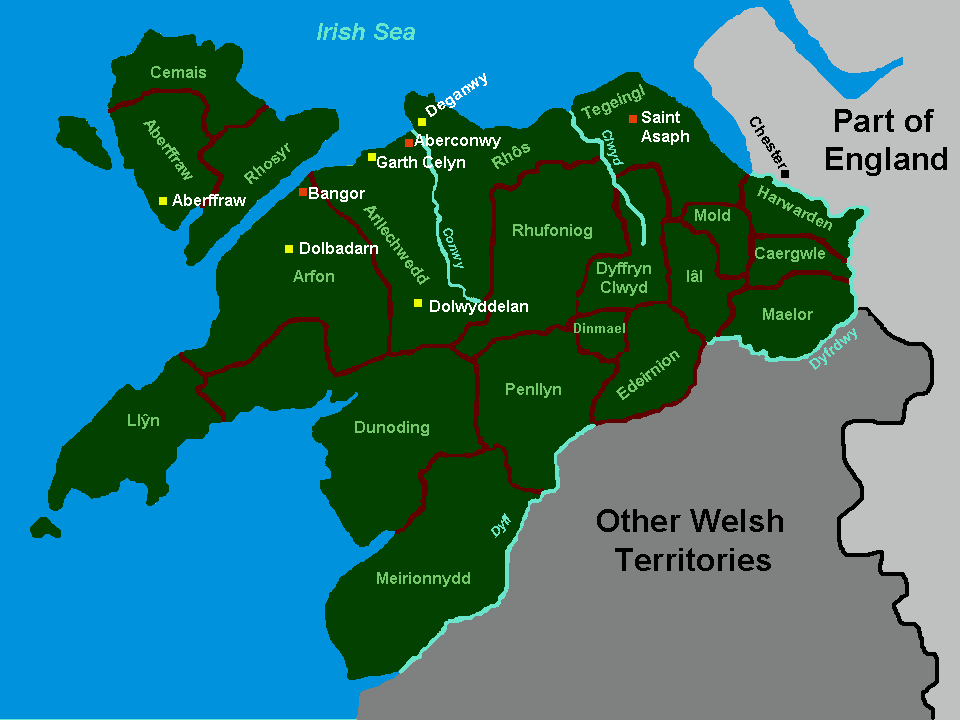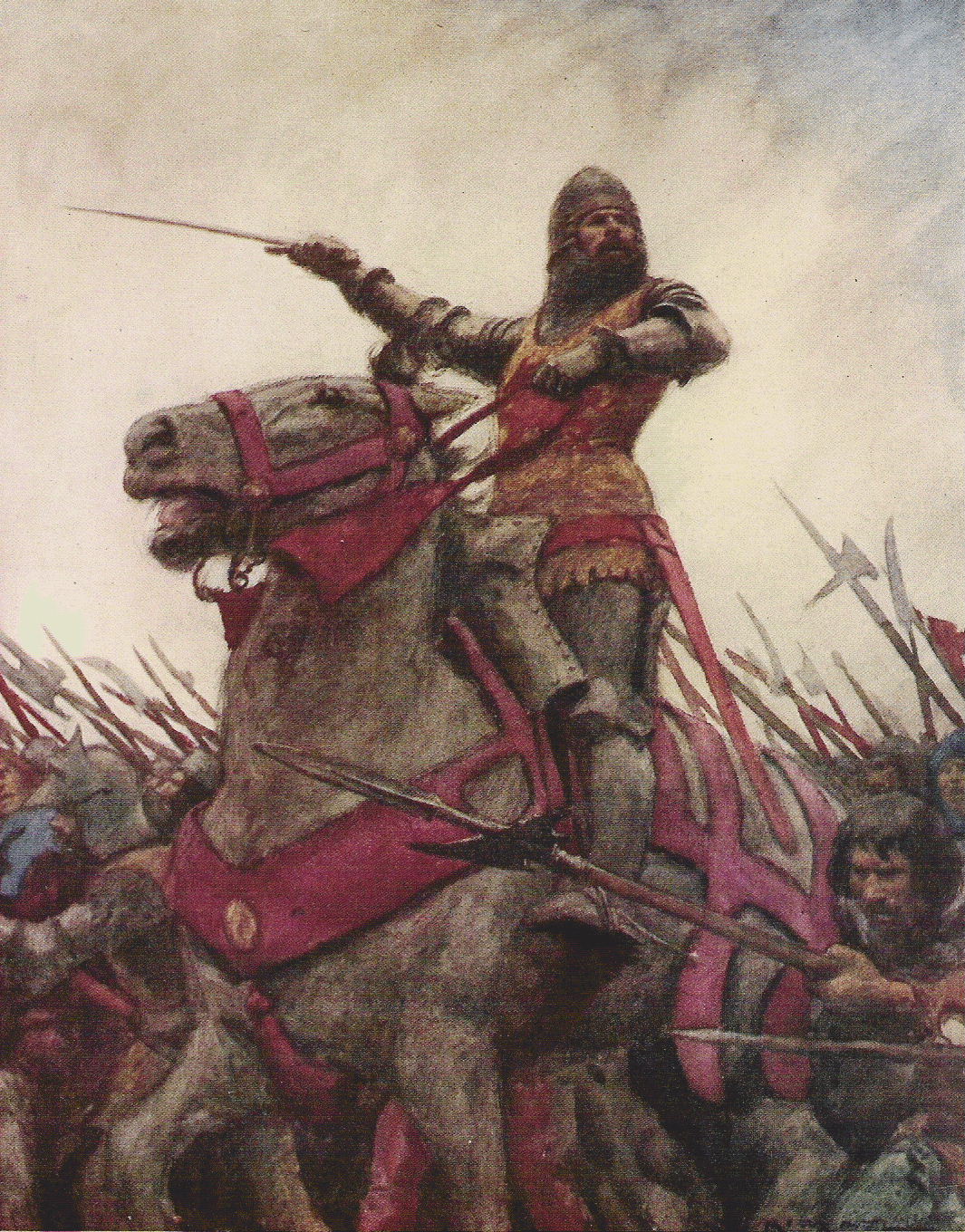|
Commote
A commote (, sometimes spelt in older documents as , plural , less frequently )'' Geiriadur Prifysgol Cymru'' (University of Wales Dictionary), p. 643 was a secular division of land in Medieval Wales. The word derives from the prefix ("together", "with") and the noun ("home, abode"). The English word "commote" is derived from the Middle Welsh . The basic unit of land was the , a small basic village or settlement. In theory, 100 made up a (literally, "one hundred settlements"; plural: ), and half or a third of a was a , although in practice the actual numbers varied greatly. Together with the , commotes were the geographical divisions through which defence and justice were organised. In charge of a commote would be a chieftain probably related to the ruling Prince of the Kingdom. His court would have been situated in a special , referred to as a . Here, the bonded villagers who farmed the chieftain's estate lived, together with the court officials and servants. Commotes were f ... [...More Info...] [...Related Items...] OR: [Wikipedia] [Google] [Baidu] |
Iâl
Ial or Yale () was a commote of medieval Wales within the cantref of Maelor in the Kingdom of Powys. When the Kingdom was divided in 1160, Maelor became part of the Princely realm of Powys Fadog (Lower Powys or Madog's Powys), and belonged to the Royal House of Mathrafal. Yale eventually merged with another commote and became the Lordship of Bromfield and Yale, later a royal lordship under the Tudors and Stuarts. History The commote of Iâl, anglicised as Yale, was the stronghold of the Principality of Powys Fadog, and its capital was at Llanarmon-yn-Iâl, in Denbighshire, Wales, in a village situated at a shrine dedicated to the Roman Bishop, Germanus of Auxerre (). The nearby castle, named Tomen y Faerdre, built next to a Neolithic cave, was erected by the first Prince of Wales, Owain Gwynedd, after capturing the commote of Yale from the last Prince of Powys, Madog ap Maredudd. The castle was later rebuilt by King John of England, signatory of Magna Carta an ... [...More Info...] [...Related Items...] OR: [Wikipedia] [Google] [Baidu] |
Cantref
A cantref ( ; ; plural cantrefi or cantrefs; also rendered as ''cantred'') was a Wales in the Early Middle Ages, medieval Welsh land division, particularly important in the administration of Welsh law. Description Land in medieval Wales was divided into ''cantrefi'', which were themselves divided into smaller commote, ''cymydau'' (commotes). The word ''cantref'' is derived from ''cant'' ("a hundred") and ''tref'' ("town" in modern Welsh language, Welsh, but formerly used for much smaller settlements). The ''cantref'' is thought to be the original unit, with the commotes being a later division. ''Cantrefi'' could vary considerably in size: most were divided into two or three commotes, but the largest, the ''Cantref Mawr'' (or "Great Cantref") in Ystrad Tywi (now in Carmarthenshire) was divided into seven commotes. History The antiquity of the ''cantrefi'' is demonstrated by the fact that they often mark the boundary between Welsh language#Dialects, dialects. Some were originally k ... [...More Info...] [...Related Items...] OR: [Wikipedia] [Google] [Baidu] |
Kingdom Of Gwynedd
The Kingdom of Gwynedd (Medieval Latin: ; Middle Welsh: ) was a Wales in the Early Middle Ages, Welsh kingdom and a Roman Empire Succession of states, successor state that emerged in sub-Roman Britain in the 5th century during the Anglo-Saxon settlement of Britain. Based in northwest Wales, the list of rulers of Gwynedd, rulers of Gwynedd repeatedly rose to dominance and were acclaimed as "King of the Britons" before losing their power in civil wars or invasions. The kingdom of Gruffydd ap Llywelynthe King of Wales from 1055 to 1063was shattered by a Timeline of conflict in Anglo-Saxon Britain, Saxon invasion in 1063 just prior to the Norman invasion of Wales, but the House of Aberffraw restored by Gruffudd ap Cynan slowly recovered and Llywelyn the Great of Gwynedd was able to proclaim the Principality of Wales at the Aberdyfi gathering of Welsh princes in 1216. In 1277, the Treaty of Aberconwy between Edward I of England and Llywelyn's grandson Llywelyn ap Gruffudd granted pe ... [...More Info...] [...Related Items...] OR: [Wikipedia] [Google] [Baidu] |
Cynllaith
Cynllaith or Cynllaeth was a commote () of north east Wales in the cantref of (later Chirkland) which was once part of the Kingdom of Powys and later part of the smaller kingdom of Powys Fadog. Cynllaith, or at least the part of it called ''Cynllaith Owain'', was part of the inheritance of Owain Glyndŵr in 1370. The titles ''Baron of Glyndyfrdwy'' and ''Lord of Cynllaith Owain'' were used by the dispossessed former ruling family of Powys Fadog before Owain was proclaimed Prince of Wales in 1400. The episode "Monk's Hood" of the Cadfael Chronicles includes a scene in a Welsh court in Llansilin Llansilin () is a village and community (Wales), community in Montgomeryshire, Powys, Wales, west of Oswestry. The community, which includes Llansilin village, a large rural area and the hamlets of Moelfre and Rhiwlas as well as the remote par ... within this commote. References Commotes History of Powys {{Wales-hist-stub ... [...More Info...] [...Related Items...] OR: [Wikipedia] [Google] [Baidu] |
Cyfraith Hywel
''Cyfraith Hywel'' (; ''Laws of Hywel''), also known as ''Welsh law'' (), was the system of law practised in medieval Wales before its final conquest by England. Subsequently, the Welsh law's criminal codes were superseded by the Statute of Rhuddlan in AD 1284 and its civil codes by Henry VIII's series of Laws in Wales Acts between 1535 and 1542. Welsh law was a form of Celtic law with many similarities to the Brehon law of Ireland and particularly the customs and terminology of the Britons of Strathclyde. It was passed down orally by jurists and bards and, according to tradition, only first codified during the reign of Hywel Dda in the mid-10th century. The earliest surviving manuscripts, however, are in Latin, date from the early 13th century, and show marked regional differences.Wade-Evans, Arthur. ''Welsh Medieval Law''. Oxford Univ., 1909. Accessed 1 Feb 2013. The law is only known to have been revised by a few rulers (particularly Bleddyn ap Cynfyn, who was cre ... [...More Info...] [...Related Items...] OR: [Wikipedia] [Google] [Baidu] |
Rhufoniog
Rhufoniog was a small sub-kingdom of the Dark Ages Gwynedd, and later a cantref in medieval Wales. Geography The cantref Rhos lay between it and the Irish Sea. Sometimes the two cantrefi were linked together as "Rhos and Rhufeiniog", which roughly corresponds to the territory of the old county of Denbighshire. The rivers Elwy, Clwyd and Clywedog formed a natural border to the north and east. As today, the countryside was bleak and isolated. There were three commotes in Rhufoniog, namely Upper Aled, Lower Aled and River Aled as a border between them, and the commote Ceinmerch (also known as 'Cymeirch' or 'Ystrad') in the north-east between the River Lliwen and the River Clywedog. History The early history of the cantref is unclear. According to tradition, it was ruled by its eponymous founder Rhufon, the third son of the first King of Gwynedd, Cunedda, and his direct descendants from the year 445 until the year 540 when it was probably absorbed back into dire ... [...More Info...] [...Related Items...] OR: [Wikipedia] [Google] [Baidu] |
Kingdom Of Gwent
Gwent () was a medieval Welsh kingdom, lying between the Rivers Wye and Usk. It existed from the end of Roman rule in Britain in about the 5th century until the Norman invasion of Wales in the 11th century. Along with its neighbour Glywysing, it seems to have had a great deal of cultural continuity with the earlier Silures, Miranda Aldhouse-Green &al. ''Gwent In Prehistory and Early History: The Gwent County History'', Vol.1. 2004. . keeping their own courts and diocese separate from the rest of Wales until their conquest by Gruffydd ap Llywelyn. Although it recovered its independence after his death in 1063, Gwent was the first of the Welsh kingdoms to be overrun following the Norman conquest. History Establishment The area has been occupied since the Paleolithic, with Mesolithic finds at Goldcliff and evidence of growing activity throughout the Bronze and Iron Age. Gwent came into being after the Romans had left Britain, and was a successor state drawing on the cultur ... [...More Info...] [...Related Items...] OR: [Wikipedia] [Google] [Baidu] |
Owain Glyndŵr
Owain ap Gruffydd (28 May 135420 September 1415), commonly known as Owain Glyndŵr (Glyn Dŵr, , anglicised as Owen Glendower) was a Welsh people, Welsh leader, soldier and military commander in the Wales in the late Middle Ages, late Middle Ages, who led a Glyndŵr rebellion, 15-year-long Welsh revolt with the aim of ending Kingdom of England, English rule in Wales. He was an educated lawyer, forming the first Welsh parliament under his rule, and was the last native-born Welshman to claim the title Prince of Wales. During the year 1400, Glyndŵr, a Welsh soldier and Glyndyfrdwy, Lord of Glyndyfrdwy had a dispute with a neighbouring Peerage of England, English Lord, the event which spiraled into a national revolt pitted common Welsh countrymen and nobles against the English military. In response to the rebellion, discriminatory Penal laws against the Welsh, penal laws were implemented against the Welsh people; this deepened civil unrest and significantly increased support for ... [...More Info...] [...Related Items...] OR: [Wikipedia] [Google] [Baidu] |
Carucate
The carucate or carrucate ( or ) was a medieval unit of land area approximating the land a plough team of eight oxen could till in a single annual season. It was known by different regional names and fell under different forms of tax assessment. England The carucate was named for the carruca heavy plough that began to appear in England in the late 9th century, which may have been introduced during the Viking invasions of England.White Jr., Lynn, The Life of the Silent Majority, pg. 88 of Life and Thought in the Early Middle Ages, ed. Robert S. Hoyt, University of Minnesota Press, Minneapolis. 1967 It was also known as a ploughland or plough (, "plough's land") in the Danelaw and usually, but not always, excluded the land's suitability for winter vegetables and desirability to remain fallow in crop rotation. The tax levied on each carucate came to be known as " carucage". Though a carucate might nominally be regarded as an area of 120 acres (49 hectares), and can usefully be equa ... [...More Info...] [...Related Items...] OR: [Wikipedia] [Google] [Baidu] |
Edeirnion
Edeirnion or Edeyrnion is an area of the county of Denbighshire and an ancient commote of medieval Wales in the cantref of Penllyn (cantref), Penllyn. According to tradition, it was named after its eponymous founder Edern ap Nudd, Edern or Edeyrn. It was included as a Welsh territory of Shropshire in the Domesday Book. Edeirnion was nominally a part of the Kingdom of Powys but was often subject to border intrusions by the neighbouring Kingdom of Gwynedd. It was the patrimony of prince Owain Brogyntyn. These rumbling border disputes caused a great deal of friction between the two realms. Edeirnion was occupied and annexed by Gwynedd in the reign of Llywelyn the Great but briefly returned to Powys following a treaty forced on Gwynedd by England after Llywelyn's death in 1240. The territory was again occupied by Gwynedd after 1267 before being returned again to Powys. This continuing dispute and the appeal by Llywelyn ap Gruffudd to Edward I of England to see the resolution of this ... [...More Info...] [...Related Items...] OR: [Wikipedia] [Google] [Baidu] |
Cantref Tegeingl
Tegeingl, known as Englefield in English, was a cantref in north-east Wales during the mediaeval period. It was incorporated into Flintshire following Edward I of England's conquest of northern Wales in the 13th century. Etymology The region's name was derived from the ''Deceangli'', an Iron Age Celtic tribe which had inhabited the region and attested since the 1st century BC. Location The cantref formed the eastern part of Perfeddwlad (or ''Y Berfeddwlad'') on the northern coast of Wales between the River Clwyd and Deeside. The territory is roughly equivalent to the modern county of Flintshire today. History Comprising the three commotes of Rhuddlan, Prestatyn and Coleshill (Cwnsyllt), the territory originally formed part of the Kingdom of Gwynedd until, in the late 8th century, it was conquered by the Anglo-Saxon Kingdom of Mercia. It remained under Mercian (or English) control for over three centuries until Dafydd ab Owain Gwynedd recovered it in the 12th century. Edw ... [...More Info...] [...Related Items...] OR: [Wikipedia] [Google] [Baidu] |








